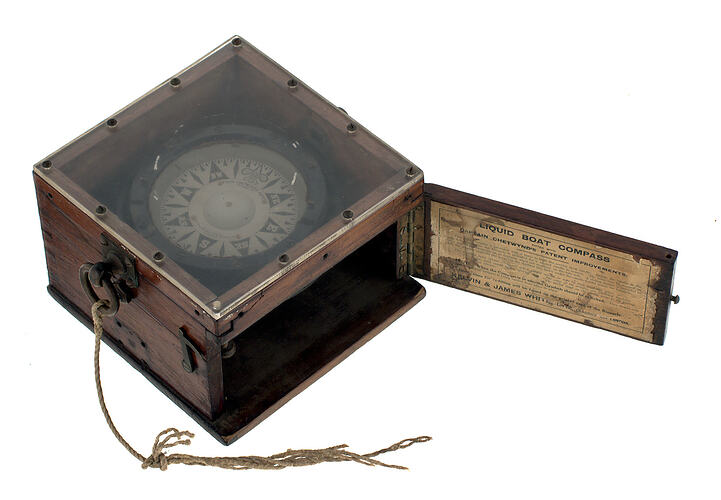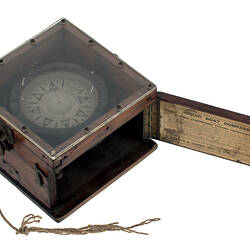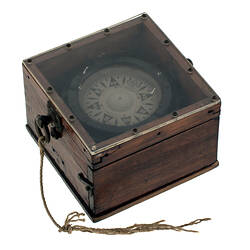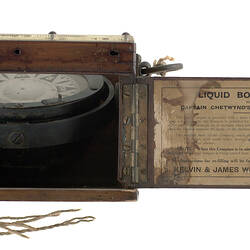Summary
Portable liquid-filled gymbal-mounted compact boat compass, incorporating Captain Chetwynd's patent improvements. Designed for use in ship's lifeboats, yachts and small watercraft. Manufactured by Kelvin & James White Ltd., Glasgow & London, Great Britain, serial no.47513, about 1910.
Captain Louis Wentworth Pakington Chetwynd (1866-1914) of the Royal Navy patented this compass dial in 1906. The design incorporated a small electric lamp or candle holder mounted in the side of the case to illuminate the dial at night.
Kelvin & James White Ltd was formed as a public company in 1900, to acquire the Glasgow-based scientific and navigational instrument making business originally established by James White (1824-1884), in 1850. White had long and highly productive working relationship with William Thomson (later-Sir William, then Lord Kelvin) (1824-1907), who held the chair as Professor of Natural Philosophy at Glasgow University from 1846-1899. White was involved from the commencement of his business in the supply and maintenance of apparatus for Thomson's university laboratory and worked with him on many experimental constructions. By 1854, White was commercially producing electrical instruments such as electrometers and electrical balances based on Thomson's designs. During 1870 White was largely responsible for equipping Sir William's laboratory in the new University premises at Gilmorehill and from 1876 was producing compasses specifically designed for use on metal ships by Sir William, which subsequently became an important part of the firm's business. The British Admiralty adopted the Thomson's patent compass as a standard for Royal Navy use in 1889. In 1899 Lord Kelvin resigned his university chair and joined Kelvin & James White Ltd as a director the following year. The company established a London office around 1904, and following Lord Kelvin's death became Kelvin Bottomley & Baird Ltd, in 1913. During WWII, the firm formed a joint venture with competitors Henry Hughes & Sons Ltd and in 1947 the two firms amalgamated as Kelvin Hughes Ltd.
Physical Description
Circular metal floating dial compass, enclosed in a liquid [oil?]-filled gymbal-mounted circular brass body inside a square wooden travelling box or case. The compass body has a circular glass window over the dial, and the wooden case has been fitted with a clear perspex lid, which is not part of the original object. The wooden case has a brass ring-pull type pivoting handle on either side and a small hinged door at the front, on the back of which is printed a paper instruction label.
More Information
-
Collecting Areas
-
Acquisition Information
Purchase
-
Patentee
Captain Louis W. Chetwynd, London, England, Great Britain, 1906
-
Manufacturer
Kelvin & James White Ltd, Glasgow, Scotland, Great Britain, circa 1910
-
Inscriptions
Painted on the dial are the eight major compass directions '<K&JW> [at North] / NE / E / SE / S / SW / W / NW /' Also on inner circle of dial: 'CAPTAIN CHETWYND'S PATENT / No. 25965/06' [below North point] & 'SOLE MAKERS / KELVIN & JAMES WHITE LTD,, 18 CAMBRIDGE ST. / GLASGOW'. Printed on paper label on inside of door at front of box: 'LIQUID BOAT COMPASS / FITTED WITH / CAPTAIN CHETWYND'S PATENT IMPROVEMENTS. / ------- / This Boat Compass is provided with a lamp to burn the service deck candle. Beside the candle in the / lamp, a holder inside the binnacle is provided for a second candle in reserve. The lamp may be shipped on / either side of the binnacle, or, in daylight, when not required, on the fore side. A sliding shutter is provided to / close the window opposite the lamp ; in the daytime this slides under the candle-holder inside the binnacle. / [italics] The detached parts of this Compass, which should always be kept in their respective places, are - / The lamp, with candle socket, spring, etc.. The cover of the window for observing bearings. The sliding shutter. The milled head on the spring lever of the locking. [end italics] / NOTE: When the Compass is in use the Gymbals should be unlocked. They should only / be locked when the Compass is being carried from place to place. / -------- / Instructions for re-filling will be found on the printed card in the Binnacle. / ------------ / KELVIN & JAMES WHITE, LTD., GLASGOW and LONDON.''
-
Brand Names
Captain Chetwynd's Patent (Marine Compasses) , K&JW (Compasses)
-
Classification
-
Category
-
Discipline
-
Type of item
-
Overall Dimensions
259 mm (Length), 215 mm (Width), 145 mm (Height)
Length including ring pull type handles on either side of case.
-
Box Dimensions
215 mm (Length), 215 mm (Width), 150 mm (Height)
External dimensions of wooden box only.
-
Other Dimensions
105 mm (Outside Diameter)
Diameter of dial.
-
References
COMPASSIPEDIA, The Online Compass Museum, [Link 1] viewed 26/03/2017. 'Kelvin Hughes', In Wikipedia, The Free Encyclopedia, [Link 2] viewed 26/03/2017. 'James White and Co', Grace's Guide to British Industrial History, [Link 3] viewed 26/03/2017. 'Kelvin and James White', Grace's Guide to British Industrial History, [Link 4] viewed 26/03/2017.
-
Keywords





